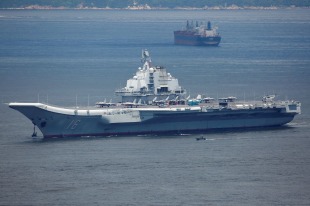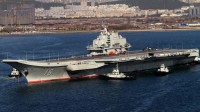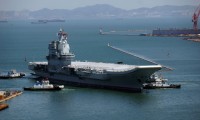Авианесущие крейсеры проекта 11435
Основная информация
Главные размерения
Машина
- Steam turbines 80,000 shp (60,000 kW)
- 200,000 shp (150,000 kW)
Персонал
Боевые силы и средства
- 12 * P-700 Granit (SS-N-19 Shipwreck) anti-ship missiles
- 192 * 3K95 Kinzhal (SA-N-9 Gauntlet) SAMs
- 8 * Kashtan CIWS mounts
- 6 * AK-630 AA guns
- 1 * UDAV-1 ASW rocket launcher
- 30–50
- 18–32 * fixed wing aircraft
- 18–24 * helicopters
- Aviation facilities:
- Angled arrested landing flight deck
- Bow ski-jump
The Kuznetsov-class aircraft carrier, Soviet designation Project 11435, is a class of fixed-wing aircraft carriers operated by the Russian and Chinese navies. Originally designed for the Soviet Navy, the Kuznetsov-class ships use a ski-jump to launch high-performance conventional aircraft in a STOBAR configuration. The design represented a major advance in Soviet fleet aviation over the Kiev-class carriers, which could only launch VSTOL aircraft. The Soviet Union's classification for the class was as a heavy aircraft-carrying cruiser, which permits the ships to transit the Turkish Straits without violating the Montreux Convention, however the Chinese variants are classified as aircraft carriers.
Because of the dissolution of the Soviet Union in 1991, the three Kuznetsov-class ships were built over a protracted construction period of almost four decades. Two ships were originally laid down at the Nikolayev South Shipyard in the Ukrainian SSR, to be followed by the first of the Ulyanovsk-class nuclear-powered supercarriers. Only the lead ship Admiral Kuznetsov had been commissioned when the Soviet Union dissolved in 1991, and the ship now serves in the Russian Navy. Construction of her sister ship Varyag was abandoned until 1998, when an independent Ukraine sold the uncompleted ship to China for use as a floating casino, along with a complete set of blueprints. Varyag was eventually completed and commissioned in 2012 as China's first aircraft carrier, the Type 001 aircraft carrier Liaoning. China subsequently constructed a third ship to a modified Type 002 design, commissioning Shandong in 2019.
The Kuznetsov-class ships were described by their Soviet builders as «heavy aircraft-carrying cruiser” – intended to support and defend strategic missile-carrying submarines, surface ships, and maritime missile-carrying aircraft of the Soviet fleet. In its fleet defense role P-700 Granit (SS-N-19 NATO reporting name: Shipwreck) anti-ship cruise missiles, 3K95 Kinzhal (Gauntlet) surface-to-air missiles, and Su-33 (Flanker-D) aircraft are its main weapons. The fixed-wing aircraft are intended for air superiority operations to protect a deployed task force. The carrier also carries numerous helicopters for anti-submarine warfare (ASW) and search and rescue (SAR) operations.
The Kuznetsov-class is the first Soviet carrier to be designed with a full-length flight deck. The ship's 12 anti-ship cruise missiles are located in launchers below the flight deck, just aft of the ski-jump.
The aircraft carriers are of a STOBAR configuration: Short Take-Off But Arrested Recovery. Short take-off is achieved by using a 12-degree ski-jump on the bow. There is also an angled deck with arresting wires, which allows aircraft to land without interfering with launching aircraft. The flight deck has a total area of 14,700 square metres (158,000 sq ft). Two aircraft elevators, on the starboard side forward and aft of the island, move aircraft between the hangar deck and the flight deck.
In the original project specifications, the ship should be able to carry up to 33 fixed-wing aircraft and 12 helicopters. The primary aircraft carried are Sukhoi Su-33 fighters, naval variants of the Sukhoi Su-27 Flanker. Kamov Ka-27 naval utility helicopters and its subsequent variants make up the helicopter wing, providing anti-submarine, maritime patrol and naval assault mobility capabilities.
The heavy surface armament makes Kuznetsov-class different from other countries' aircraft carriers, which carry only defensive armament and rely on their aircraft for strike power.
Корабли3
- Комментарии
 ru
ru en
en uk
uk







 Военно-Морской Флот СССР
Военно-Морской Флот СССР Военно-Морской Флот Российской Федерации
Военно-Морской Флот Российской Федерации Военно-морской флот Народно-освободительной армии Китая
Военно-морской флот Народно-освободительной армии Китая Черноморский судостроительный завод
Черноморский судостроительный завод Dalian Shipbuilding Industry Company
Dalian Shipbuilding Industry Company

